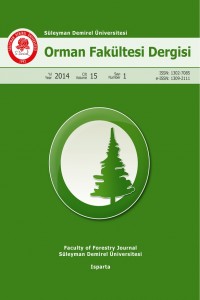Öz
The proportion of durable soil areas is steadily decreasing for some reasons such as drought, erosion, landslide and excessive rain fall in the all world. Therefore, usable areas are steadily reducing and the significance of usable land is increasing due to the rapid increase in construction. The importance of slope stabilization is increased because sloping terrains (slope) are more easily affected by such problems and as a result of these effects they lose their use of function. Today, slump and sliding problems of human-made or natural slopes have become an important topic in many disciplines and many different strengthening methods have been developed to solve these problems. In this study, plant applications as an important method for strengthening grounds and slopes are dealt and slope stabilization based on different plant species and their effects on retaining wall are researched. For this purpose, a sample slope structure with a retaining wall is modeled by using finite element method and the positive and negative effects of Juniperus horizontalis and Pittosporum tenuifolium plants on this model are observed. Results of the finite element analyses show that plant roots on the slopes provide improvements in terms of displacement and stress and plant roots on the surface has a greater effect on the slope stabilization.
Keywords: Slope slope stabilization, Plant, Retaining wall, Finite element method, Static analysis
Anahtar Kelimeler
Slope slope stabilization Plant Retaining wall Finite element method Static analysis
Kaynakça
- Anonim, 2013a. http://aris.ormansu.gov.tr/index.php?q=tr/ toprak/turkiyede_erozyon (Ziyaret Tarihi: 15.01.2013)
- Anonim, 2013b. http://en.wikipedia.org/wiki/ Pittosporum _tenuifolium (Ziyaret tarihi: 24.10.2013)
- Anonim, 2013c. http://icm.landcareresearch.co.nz/research /freshwater/documents/Kohuhu.pdf (Ziyaret Tarihi: 13.01.2013)
- Anonim, 2013d. Photo by Phil Bendle, http://www. terrain.net.nz/friends-of-te-henui-group/table- 1/kohuhu.html (Ziyaret tarihi: 24.10.2013)
- Anonim, 2013e. http://en.wikipedia.org/wiki/Juniperus_ horizontalis (Ziyaret tarihi: 24.10.2013)
- Anonim, 2013f. www.wikipedia.org/wiki/Juniper (Ziyaret Tarihi: 22.01.2013)
- ANSYS, 2012. Finite Element Analysis Software Version 14.0. USA.
- Erpul, G., Saygın, S.D., 2012. Ülkemizdeki toprak erozyonu sorunu üzerine: Ne yapmalı? Toprak Bilimi ve Bitki Besleme Dergisi, 1(1): 26-32.
- Fahjan, Y., 2013. Sonlu Elemanlar Yöntemi. Teknik Not, Gebze İleri Teknoloji Enstitüsü, Deprem ve Yapı Mühendisliği Bölümü, Kocaeli, Türkiye.
- Marden, M., Rowan, D., Philips, C., 2005. Stabilising characteristing of New Zealand indigenous riparian colonising plants. Journal of Plant and Soil, India, 278: 1-2.
- Uzuner, B.A., 2007. Çözümlü Problemlerle Temel Zemin Mekaniği. Derya Kitapevi, Trabzon, Türkiye.
- Wait, R., Mitchell, A.R., 1985. Finite Element Analysis and Applications. J. Wiley Inc., Liverpool, England.
- Yavuzşefik, Y., 1998. Peyzaj Onarım Tekniği. Teknik Not. Abant İzzet Baysal Üniversitesi, Orman Fakültesi, Düzce.
- Yılmaz, G., Tutuk, T., Özsoy, E.A., 2008. Kayma dairesi göçme mekanizması için plastik stabilite çözümü. Eskişehir Osmangazi Üniversitesi, Müh. Mim. Fak. Dergisi, 21(2): 75-84.
Öz
Dünyada ve Türkiye'de kuraklık, erozyon, heyelan ve aşırı yağış gibi nedenlerden yapılaşmanın büyük oranlarda artması nedeniyle yapılaşmaya elverişli arazilere verilen önem artmaktadır. Özellikle eğimli arazilerin bu tür problemlerden daha kolay etkilenmesi ve bu etkiler sonucunda kullanım fonksiyonlarını kaybetmesi şev stabilizasyonun önemini arttırmıştır. Günümüzde doğal yamaçlar veya yapay yollarla elde edilen şevlerin göçme ve kayma problemleri birçok disiplin açısından oldukça önemli bir konu haline gelmiş ve bu problemin çözümü için birçok farklı güçlendirme yöntemleri geliştirilmiştir. Bu çalışmada zeminlerin ve şevlerin güçlendirilmesinde önemli bir uygulama yöntemi olarak bilinen bitkilendirme çalışmaları ele alınmış ve farklı bitki türlerine dayalı şevlerin stabilizasyonu ve istinat duvarı üzerindeki etkileri araştırılmıştır. Bu amaçla, örnek bir şev yapısı istinat duvarıyla birlikte sonlu elemanlar yöntemiyle modellenmiş ve bu model üzerinde Juniperus horizontalis (Yayılıcı Ardıç) ve Pittosporum tenuifolium bitkilerinin oluşturacağı olumlu ve olumsuz etkiler gözlemlenmiştir. Sonlu eleman analizleri sonucunda bitki köklerinin şevler üzerinde yer değiştirme ve gerilme açısından iyileştirmeler sağladığı ve bitki köklerinin yüzeysel olarak yayılması durumunda bu iyileştirmelerin daha da arttığı tespit edilmiştir.
Anahtar kelimeler: Şev stabilizasyonu, Bitkilendirme, İstinat duvarı, Sonlu elemanlar yöntemi, Statik analiz
Anahtar Kelimeler
Şev stabilizasyonu Bitkilendirme İstinat duvarı Sonlu elemanlar yöntemi Statik analiz
Kaynakça
- Anonim, 2013a. http://aris.ormansu.gov.tr/index.php?q=tr/ toprak/turkiyede_erozyon (Ziyaret Tarihi: 15.01.2013)
- Anonim, 2013b. http://en.wikipedia.org/wiki/ Pittosporum _tenuifolium (Ziyaret tarihi: 24.10.2013)
- Anonim, 2013c. http://icm.landcareresearch.co.nz/research /freshwater/documents/Kohuhu.pdf (Ziyaret Tarihi: 13.01.2013)
- Anonim, 2013d. Photo by Phil Bendle, http://www. terrain.net.nz/friends-of-te-henui-group/table- 1/kohuhu.html (Ziyaret tarihi: 24.10.2013)
- Anonim, 2013e. http://en.wikipedia.org/wiki/Juniperus_ horizontalis (Ziyaret tarihi: 24.10.2013)
- Anonim, 2013f. www.wikipedia.org/wiki/Juniper (Ziyaret Tarihi: 22.01.2013)
- ANSYS, 2012. Finite Element Analysis Software Version 14.0. USA.
- Erpul, G., Saygın, S.D., 2012. Ülkemizdeki toprak erozyonu sorunu üzerine: Ne yapmalı? Toprak Bilimi ve Bitki Besleme Dergisi, 1(1): 26-32.
- Fahjan, Y., 2013. Sonlu Elemanlar Yöntemi. Teknik Not, Gebze İleri Teknoloji Enstitüsü, Deprem ve Yapı Mühendisliği Bölümü, Kocaeli, Türkiye.
- Marden, M., Rowan, D., Philips, C., 2005. Stabilising characteristing of New Zealand indigenous riparian colonising plants. Journal of Plant and Soil, India, 278: 1-2.
- Uzuner, B.A., 2007. Çözümlü Problemlerle Temel Zemin Mekaniği. Derya Kitapevi, Trabzon, Türkiye.
- Wait, R., Mitchell, A.R., 1985. Finite Element Analysis and Applications. J. Wiley Inc., Liverpool, England.
- Yavuzşefik, Y., 1998. Peyzaj Onarım Tekniği. Teknik Not. Abant İzzet Baysal Üniversitesi, Orman Fakültesi, Düzce.
- Yılmaz, G., Tutuk, T., Özsoy, E.A., 2008. Kayma dairesi göçme mekanizması için plastik stabilite çözümü. Eskişehir Osmangazi Üniversitesi, Müh. Mim. Fak. Dergisi, 21(2): 75-84.
Ayrıntılar
| Birincil Dil | Türkçe |
|---|---|
| Bölüm | Orijinal Araştırma Makalesi |
| Yazarlar | |
| Yayımlanma Tarihi | 26 Mayıs 2014 |
| Yayımlandığı Sayı | Yıl 2014 Cilt: 15 Sayı: 1 |


